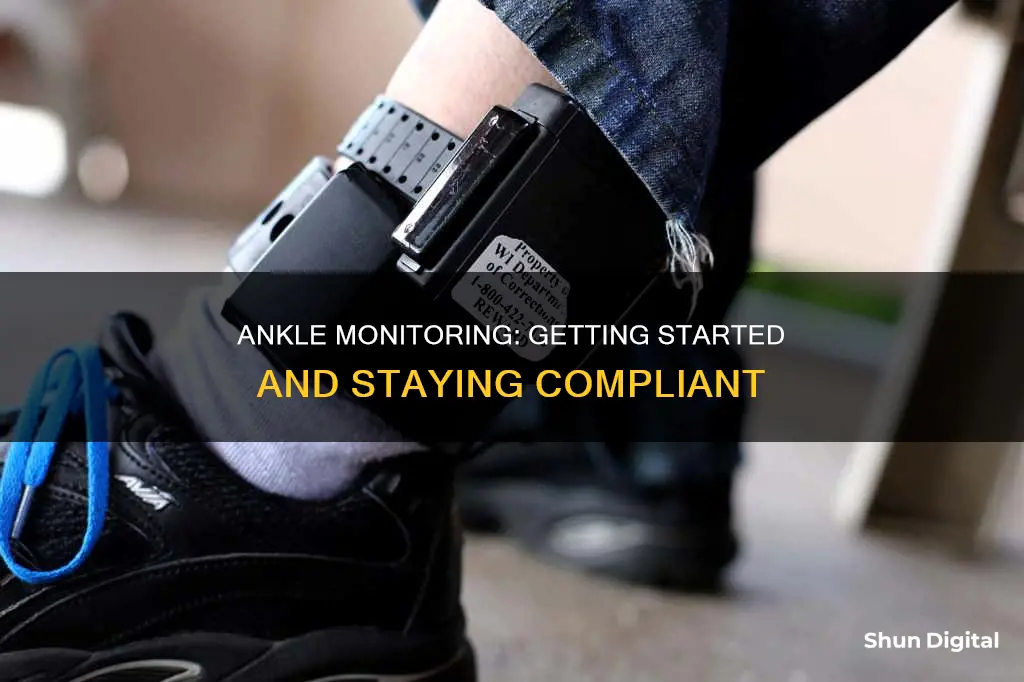
Ankle monitoring is a form of surveillance that uses an electronic device affixed to an individual's ankle. It is often used as an alternative to incarceration, allowing offenders controlled freedom while maintaining public safety. The technology typically involves GPS or radio frequency to transmit location data to a monitoring centre, ensuring compliance with court-ordered movement restrictions. Ankle monitors can also detect alcohol consumption, making them useful for enforcing restrictions on individuals with alcohol-related offences. While ankle monitoring can be a less restrictive option than incarceration, it has been criticised for failing to meet its goals of ensuring court appearances, protecting public safety, and advancing rehabilitation.
| Characteristics | Values |
|---|---|
| Purpose | Surveillance tool for individuals on parole, house arrest, or bail |
| Users | People with substance abuse issues, awaiting trial, serving probation, or facing immigration proceedings |
| Technology | GPS, Radio Frequency (RF), or a combination of both |
| Features | Waterproof, lightweight, and locked into place with inbuilt sensors |
| Alcohol Monitoring | Secure Continuous Remote Alcohol Monitor (SCRAM) bracelet detects alcohol in sweat |
| Movement | Restricted to home or permitted to travel to work, religious services, meetings, or medical services |
| Alerts | Notifies authorities if the user leaves the designated area, tampers with the device, or consumes alcohol |
| Charging | Requires charging for 2 hours daily; vibrates when connected/disconnected and when battery is low |
| Installation | 30-second tool-free installation |
| Cost | $3-$35 per day, with initial setup charges ranging from $100 to $200 |
What You'll Learn

How ankle monitors work
Ankle monitors are a form of electronic tagging, a type of surveillance that uses an electronic device affixed to an individual. Ankle monitors are typically worn around the lower leg and are used to track the movements of individuals who have been sentenced to restricted travel or activities. The device uses GPS tracking systems to record the location of the wearer. This includes people awaiting trial, serving probation and parole, and facing immigration proceedings.
The ankle monitor helps to ensure that individuals abide by the terms of their sentence. For example, it can track whether an individual is violating the terms of their sentence regarding sobriety. A Secure Continuous Remote Alcohol Monitor (SCRAM) bracelet can detect alcohol in a person's sweat, alerting authorities if the person violates the terms of their release by drinking.
Ankle monitors are also used to ensure that individuals remain within the boundaries of their restricted travel areas. They can be set up to notify authorities if the wearer ventures outside of a certain range or designated area. The monitor typically sends a regular signal to a receiver unit installed in the individual's home, and authorities are alerted if the signal is interrupted or moves outside of the designated range.
The battery life of an ankle monitor can vary, but typically, with a full charge, it can last anywhere from 12 hours to about 2.5-3 days. Over time, the battery life depletes, and the device will need to be charged more frequently. Individuals are given a charger and strict rules about charging the monitor, with consequences for non-compliance.
Ankle monitors are designed to be tamper-proof, with features such as a fiber optic cable that runs through the strap and connects to the 'box' on both sides. If the fiber optic connection is interrupted, it triggers an alert, notifying authorities that the strap has been tampered with.
While ankle monitors have been criticised for their impact on civil liberties and privacy, they have also been credited for their effectiveness in deterring crime and ensuring compliance with court orders. They offer an alternative to incarceration, particularly for individuals with substance abuse issues, providing an opportunity for diversion and rehabilitation.
Resetting Your ASUS Monitor: Back to Basics
You may want to see also

Who uses ankle monitors
Ankle monitors are typically used for individuals who are on probation or parole, or for those who are awaiting trial. They are often used as an alternative to traditional imprisonment, allowing individuals to serve their sentences while remaining in the community and maintaining their jobs and family lives. Ankle monitors are also used for individuals convicted of a crime who are considered low-risk and not a danger to the community.
In the state of Indiana, ankle monitors are a common condition of probation, which is itself a common alternative to incarceration. Offenders are offered probation when the crimes they have been convicted of don't warrant jail time, and they would be better served by remaining in the community under supervision. The terms of probation are tailored to each case, reflecting the nature of the offence and the needs of the individual and community.
Ankle monitors are also used for those with substance abuse issues, as an alternative to prison, which can often be the worst place for someone suffering from addiction. In Washington State, for example, DUI laws have been strengthened, and it has become easier for SCRAM bracelets to be used for first-time and nonviolent offenders. This has allowed individuals to avoid jail time while working through drug and alcohol treatment programs from home.
Ankle monitors are also used for sex and violent offenders, and in cases of domestic violence. GPS location monitoring is a useful alternative to incarceration for community corrections, helping officers more effectively supervise clients while enhancing community safety.
Differentiating Speakers and Monitors: A Quick Guide
You may want to see also

The benefits of ankle monitors
Ankle monitors are typically used to track the movements of individuals who have been sentenced to restricted travel or activities. They are often used as an alternative to prison or jail time, and can be used to monitor people awaiting trial, serving probation and parole, or facing immigration proceedings. Here are some of the benefits of ankle monitors:
Reducing Recidivism and Promoting Rehabilitation:
Ankle monitors can help reduce the risk of reoffending by providing a level of supervision and accountability. In some cases, they may offer positive reinforcement and assist in the rehabilitation process. For example, in the case of substance abuse issues, ankle monitors with alcohol monitoring capabilities can help ensure compliance with sobriety requirements.
Cost-Effectiveness:
Ankle monitors are often seen as a more cost-effective alternative to incarceration. They can reduce the costs associated with imprisoning individuals, especially for non-violent or low-risk offenders. Additionally, by allowing individuals to remain in their communities, ankle monitors can help reduce the societal costs associated with incarceration, such as loss of productivity and the breakdown of families.
Public Safety:
Ankle monitors can enhance public safety by providing a way to monitor and track the movements of individuals who may pose a risk to society. This is especially beneficial in cases of domestic violence, where victims can be given greater peace of mind knowing that their abuser is being monitored and can be quickly located if needed.
Flexibility and Targeted Monitoring:
Ankle monitors offer flexibility in terms of the level of restriction imposed. Depending on the sentence, individuals may be restricted to their homes or permitted to travel to work or other approved locations. This targeted monitoring approach allows for a balance between supervision and the individual's freedom to carry out daily activities.
Health and Well-being:
In certain situations, ankle monitors can have a positive impact on the health and well-being of the wearer. For example, in cases of substance abuse, ankle monitors can provide a sense of structure and accountability, aiding in the recovery process. Additionally, for individuals with mental health issues or dementia, ankle monitors can provide a sense of security and prevent them from wandering off or getting lost.
Does Your Monitor Have Adaptive Sync? Here's How to Tell
You may want to see also

The drawbacks of ankle monitors
Ankle monitors are increasingly being used as an alternative to incarceration, allowing people to pay their debt to society while providing for their families. However, this technology comes with several drawbacks that can negatively impact the lives of those who wear them and fail to meet their stated goals.
One significant drawback of ankle monitors is the financial burden they place on the wearer. The cost of renting and maintaining these devices can be substantial, ranging from $3 to $35 per day, with additional setup charges that can reach $200. These expenses can be particularly onerous for individuals from impoverished or marginalised communities, as they compound the financial challenges of re-entering society after incarceration. In some cases, the cost of the monitor can lead to homelessness, as individuals struggle to cover both the cost of the device and their basic living expenses.
Another drawback is the restriction on movement and the constant surveillance that ankle monitors entail. Wearers are often confined to specific areas, with limited approved movement hours that can be difficult to adjust. This lack of flexibility can make it challenging for individuals to work, attend school, or access necessary services. The stigma associated with wearing an ankle monitor can also lead to social isolation and stress, exacerbating mental health issues.
Furthermore, ankle monitors have been criticised for their potential to exacerbate systemic inequities. Studies have shown that in some jurisdictions, Black people are twice as likely as white people to be electronically monitored. This disparity contributes to the overrepresentation of racial minorities in the criminal justice system and can have long-lasting consequences on their lives.
Additionally, ankle monitors have been found to be faulty and imprecise in some cases. They may lose their GPS signal or generate frequent false alerts, causing unnecessary stress and anxiety for the wearer. The constant charging requirements can also be inconvenient and restrictive, with wearers needing to remain tethered to a power outlet for extended periods.
Lastly, ankle monitors have been criticised for their role in expanding mass incarceration. Minor technical violations, charging malfunctions, and false alarms related to the devices can lead to individuals being sent back to jail or prison. This perpetuates a cycle of incarceration and further entrenches individuals in the criminal justice system.
While ankle monitors are intended to provide an alternative to incarceration, these drawbacks highlight the need for more effective and humane approaches to criminal justice and rehabilitation.
Ankle Monitors: Removable, but at What Cost?
You may want to see also

The types of ankle monitors
Ankle monitors are a form of surveillance that uses an electronic device affixed to an individual's ankle. They are often used as an alternative to traditional imprisonment, allowing individuals to serve their sentences while remaining in the community. Ankle monitors are typically used for individuals on probation or parole, or those awaiting trial. They can also be used for individuals convicted of a crime but considered low-risk.
There are several types of ankle monitors, each with different features and functions:
Radio Frequency Monitors
Radio frequency (RF) monitors do not provide the wearer's exact location but notify authorities when the wearer enters or deviates from a designated location. These monitors are commonly used in curfew and house arrest cases, requiring the wearer to be in a specific location at a specific time. RF technology remains the most effective monitoring technology to verify the presence of an individual under supervision during specified hours.
Global Positioning System (GPS) Monitors
GPS monitors are more precise and can relay location data according to specified intervals or continuously. These monitors are typically reserved for offenders who are allowed to travel and have a pre-arranged schedule. GPS monitors are also used to restrict certain offenders from approaching specific people or places, such as sex offenders who cannot get close to children's schools. GPS technology can detect the location of the wearer through GPS satellites, cellular towers, and/or Wi-Fi.
Secure Remote Continuous Alcohol Monitoring System
While this type of monitor can also relay location data, its primary function is to detect alcohol consumption levels. It does so by monitoring alcohol content in the wearer's sweat regularly and forwarding the data to monitoring agencies. This type of monitor is particularly relevant for individuals who have committed alcohol-related offences.
Opening the Acer LCD Monitor H163HQ: Step-by-Step Guide
You may want to see also
Frequently asked questions
An ankle monitor is a device worn around the lower leg that uses GPS or radio frequency technology to track the movements of individuals who have been sentenced to restricted travel or activities.
Ankle monitors are typically worn by individuals on parole, probation, or house arrest. They may also be used for those with substance abuse issues or awaiting trial.
Ankle monitors use GPS or radio frequency technology to transmit location data to a monitoring centre, ensuring compliance with court-ordered movement restrictions. Some ankle monitors can also detect alcohol consumption.
Ankle monitoring can be a useful alternative to incarceration, helping to reduce prison populations and allowing individuals to undergo rehabilitation from the comfort of their own homes. It also provides a level of supervision and monitoring that might otherwise require a law enforcement officer.







